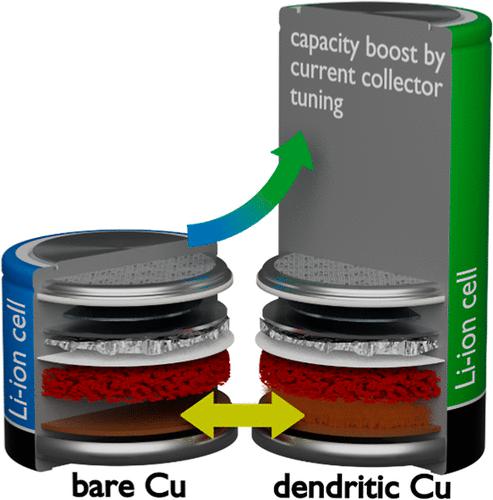当前位置:
X-MOL 学术
›
ACS Appl. Mater. Interfaces
›
论文详情
Our official English website, www.x-mol.net, welcomes your
feedback! (Note: you will need to create a separate account there.)
Dendritic Copper Current Collectors as a Capacity Boosting Material for Polymer-Templated Si/Ge/C Anodes in Li-Ion Batteries
ACS Applied Materials & Interfaces ( IF 8.3 ) Pub Date : 2024-01-03 , DOI: 10.1021/acsami.3c15735 Christian L Weindl 1 , Christian E Fajman 2 , Zhuijun Xu 1 , Tianle Zheng 1 , Gilles E Möhl 3 , Narendra Chaulagain 4 , Karthik Shankar 4 , Ralph Gilles 3 , Thomas F Fässler 2 , Peter Müller-Buschbaum 1, 3
ACS Applied Materials & Interfaces ( IF 8.3 ) Pub Date : 2024-01-03 , DOI: 10.1021/acsami.3c15735 Christian L Weindl 1 , Christian E Fajman 2 , Zhuijun Xu 1 , Tianle Zheng 1 , Gilles E Möhl 3 , Narendra Chaulagain 4 , Karthik Shankar 4 , Ralph Gilles 3 , Thomas F Fässler 2 , Peter Müller-Buschbaum 1, 3
Affiliation

|
Dendritic copper offers a highly effective method for synthesizing porous copper anodes due to its intricate branching structure. This morphology results in an elevated surface area-to-volume ratio, facilitating shortened electron pathways during aqueous and electrolyte permeation. Here, we demonstrate a procedure for a time- and cost-efficient synthesis routine of fern-like copper microstructures as a host for polymer-templated Si/Ge/C thin films. Dissolvable Zintl clusters and sol–gel chemistry are used to synthesize nanoporous coating as the anode. Cyclic voltammetry (CV) with KOH as the electrolyte is used to estimate the surface area increase in the dendritic copper current collectors (CCs). Half cells are assembled and tested with battery-related techniques such as CV, galvanostatic cycling, and electrochemical impedance spectroscopy, showing a capacity increase in the dendritic copper cells. Energy-dispersive X-ray spectroscopy is used to estimate the removal of K in the bulk after oxidizing the Zintl phase K12Si8Ge9 in the polymer/precursor blend with SiCl4. Furthermore, scanning electron microscopy images are provided to depict the thin films after synthesis and track the degradation of the half cells after cycling, revealing that the morphological degradation through alloying/dealloying is reduced for the dendritic Cu CC anodes as compared with the bare reference. Finally, we highlight this time- and cost-efficient routine for synthesizing this capacity-boosting material for low-mobility and high-capacity anode coatings.
中文翻译:

树枝状铜集流体作为锂离子电池中聚合物模板化 Si/Ge/C 阳极的容量增强材料
由于其复杂的支化结构,树枝状铜为合成多孔铜阳极提供了一种高效的方法。这种形态导致表面积与体积比升高,有利于在水和电解质渗透过程中缩短电子路径。在这里,我们展示了一种省时且经济高效的蕨类铜微结构合成程序,作为聚合物模板 Si/Ge/C 薄膜的主体。可溶性 Zintl 簇和溶胶-凝胶化学用于合成纳米多孔涂层作为阳极。使用 KOH 作为电解质的循环伏安法 (CV) 来估计树枝状铜集流体 (CC) 的表面积增加。使用CV、恒电流循环和电化学阻抗谱等电池相关技术组装和测试半电池,结果显示树枝状铜电池的容量有所增加。能量色散X射线光谱用于估计用SiCl 4氧化聚合物/前体共混物中的Zintl相K 12 Si 8 Ge 9后本体中K的去除。此外,还提供了扫描电子显微镜图像来描绘合成后的薄膜并跟踪循环后半电池的降解,表明与裸露参考相比,树枝状 Cu CC 阳极通过合金化/脱合金导致的形态降解减少了。最后,我们强调了这种节省时间和成本效益的程序,用于合成这种用于低迁移率和高容量阳极涂层的容量增强材料。
更新日期:2024-01-03
中文翻译:

树枝状铜集流体作为锂离子电池中聚合物模板化 Si/Ge/C 阳极的容量增强材料
由于其复杂的支化结构,树枝状铜为合成多孔铜阳极提供了一种高效的方法。这种形态导致表面积与体积比升高,有利于在水和电解质渗透过程中缩短电子路径。在这里,我们展示了一种省时且经济高效的蕨类铜微结构合成程序,作为聚合物模板 Si/Ge/C 薄膜的主体。可溶性 Zintl 簇和溶胶-凝胶化学用于合成纳米多孔涂层作为阳极。使用 KOH 作为电解质的循环伏安法 (CV) 来估计树枝状铜集流体 (CC) 的表面积增加。使用CV、恒电流循环和电化学阻抗谱等电池相关技术组装和测试半电池,结果显示树枝状铜电池的容量有所增加。能量色散X射线光谱用于估计用SiCl 4氧化聚合物/前体共混物中的Zintl相K 12 Si 8 Ge 9后本体中K的去除。此外,还提供了扫描电子显微镜图像来描绘合成后的薄膜并跟踪循环后半电池的降解,表明与裸露参考相比,树枝状 Cu CC 阳极通过合金化/脱合金导致的形态降解减少了。最后,我们强调了这种节省时间和成本效益的程序,用于合成这种用于低迁移率和高容量阳极涂层的容量增强材料。































 京公网安备 11010802027423号
京公网安备 11010802027423号